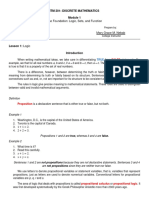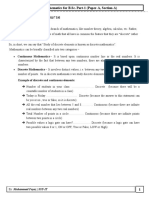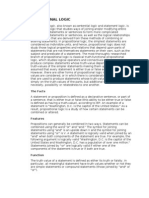Discrete Math 2
Discrete Math 2
Uploaded by
Nicole Marie RodrigoCopyright:
Available Formats
Discrete Math 2
Discrete Math 2
Uploaded by
Nicole Marie RodrigoCopyright
Available Formats
Share this document
Did you find this document useful?
Is this content inappropriate?
Copyright:
Available Formats
Discrete Math 2
Discrete Math 2
Uploaded by
Nicole Marie RodrigoCopyright:
Available Formats
Republic of the Philippines
NORTHERN ILOILO POLYTECHNIC STATE COLLEGE
Lemery Campus
Lemery, Iloilo
Module 1, Lesson 2
Mathematical Logic
(Conditional Proposition & Equivalence Proposition)
Introduction:
In English or in Mathematics, it is common to encounter sentences that contain certain type of condition. When
you make a logical inference or deduction, you reason from hypothesis to a conclusion. Your aim is to be able to say, “If
such and such is known, then something must be the case.”
Imagine that you are trying to solve a problem involving three statements: p, q and r. Suppose you know that
the truth of r follows from the truth of p and also that the truth of r follows from the truth of q. Then no matter whether
p or q is the case, the truth of r must follow.
Learning Outcomes:
Upon completion of this module, you are expected to:
1. Discuss conditional proposition and equivalence proposition.
2. Write the given sentence in If then form and decide its truth value.
3. Give the converse of the given implications and decide its truth value.
4. Write the given sentence in If and only if form and decide its truth value.
Discussion:
Consider the following sentences:
(1) If I study every day, then I will pass Algebra.
(2) If x is even, then x is divisible by 2.
Note that in either case, a condition under which a particular phenomenon will occur is clearly implied. Thus the first
sentence states the condition in order to pass the course in algebra while the second sentence states the condition
under which x is to be divisible by 2. Relative to sentence structure, both are expressed in the form “If …,then…” The
importance of this form to us lies on the fact that many propositions (definitions and theorems) in mathematics are
generally expressed this way.
Definition 1.4 If p and q are propositions, then the proposition “If p, then q” denoted symbolically by p q is called a
conditional proposition or an implication.
The logical connective “if …, then …” is called a conditional connective and is denoted by the symbol called
the implication sign. The expression p q is read “p implies q” . The proposition p is called the antecedent ( or
hypothesis) and q is called the consequence ( or conclusion). In the statement “If x is even, then x is divisible by 2”, the
antecedent is “x is even” and the consequent is “x is divisible by 2.”
Table 1 - F
p q p q
T T T
T F F
F T T
F F T
The truth table for p q is given by table 1 – F. This table shows that the only way for an implication to be
false is when its antecedent is true and its consequent is false.
Example
1. p = “3 is odd.” And q = 3 2 is even.”
The implication is a false proposition since p is true and q is false.
Discrete Mathematics Narra P. Listano, M.A.Ed.
NIPSC – LC BSIT Professor
Second Semester 2020 - 2021
Definition 1.5 If p and q denote propositions, the implications q p is called the converse of p q.
Table 1 – G is a combination of the truth tables of p q and the converse q p. This table shows that
whenever of p q and the converse q p. are both true, their components are either true together (TT) or false
together (FF).
Table 1 - G
p q p q q p
T T T T
T F F T
F T T F
F F T T
Example: p q = “If x = 2, then x + 3 = 5 ,” is TRUE
q p = “If x + 3 = 5, then x = 2,” Is TRUE.
Definition 1. 6 If p and q are propositions, the statement “p if and only if” denoted by p q is the shortened form
for (p q) ꓥ (q p)
Table 1 - F
p q p q
T T T
T F F
F T F
F F T
Example If p = “Triangles are similar.”
q = “Triangles are congruent.”
Then p q is false because not all similar triangles are congruent.
Summary:
If p and q are propositions, then the proposition “If p, then q” denoted symbolically by p q is
called a conditional proposition or an implication.
If p and q denote propositions, the implications q p is called the converse of p q.
Assessment:
A. Write the following pairs of sentences in the If then form and decide its truth value.
1. 3 + 3 = 6, 3(3) ≠6 4. X2 = 36, x = 6 or x = -6
2. x = 5, x2 = 25 5. 8 is divisible by 4, 8 + 4 is odd
3. 1 = 2, 1 + 2 is even 6. Taal is in Laguna, Laguna is in Luzon
Discrete Mathematics Narra P. Listano, M.A.Ed.
NIPSC – LC BSIT Professor
Second Semester 2021- 2022
B. Express each of the following in the If then form expressing the same idea as the given statement.
1. Two lines intersect only if they are not parallel.
2. I get paid only when I have worked.
3. A three – sided figure is a triangle.
4. A prime number greater than 5 is odd.
5. Congruent triangles are similar triangles.
6. An even integer is divisible by 2.
C. Write each of the following in the if and only if form and decide its truth value.
1. If a polygon has three sides, then it is a triangle.
2. If x2 = 16, then x = 4.
3. The vector sum of forces in equilibrium is zero.
4. 8 ÷ 2 = 4 only when 8 = 4(2).
5. If two numbers are equal, their squares are equal.
6. An equilateral triangle has three equal sides.
D. Give the converse of the following implications and determine the truth value.
1. If a triangle is equilateral, then it is isosceles.
2. If x = 10, then x2 = 100.
3. If two lines are parallel, then they are equidistant.
4. If 3 x 2 - 6x = 0, then x = 0.
5. If a polygon is a square, then it is a rectangle.
6. If x = 1 or x = -1, then x 2 -1 = 0
References:
1. Cabero, Jonathan B., et al, Discrete Mathematics, (2010), Navotas Press, Navotas City Philippines
2. Epp, Sussana S., ( 2012 ), Discrete Mathematics, Hiyas Press Inc., Pasig City, Philippines
3. Feliciano, Florentino T., ( 1991) Modern College Algebra, Merriam and Webster Inc. Manila, Philippines
You might also like
- Knowledge Representation in Artificial IntelligenceDocument19 pagesKnowledge Representation in Artificial IntelligenceSweeti Sah100% (5)
- Reading and Thinking Strategies Across Text TypesDocument16 pagesReading and Thinking Strategies Across Text TypesJane Sagutaon50% (2)
- Orca Share Media1567413377305Document4 pagesOrca Share Media1567413377305Maria May OcheaNo ratings yet
- Logic PresentationDocument36 pagesLogic Presentationesta2310819No ratings yet
- UntitledDocument5 pagesUntitledNerlyn Gallego ParNo ratings yet
- Discrete Structure Lecture 1Document33 pagesDiscrete Structure Lecture 1saddiquewaheed5No ratings yet
- General Mathematics: Quarter 2 - Module 8Document14 pagesGeneral Mathematics: Quarter 2 - Module 8Eleanor CabungcagNo ratings yet
- Introduction of PropositionDocument29 pagesIntroduction of PropositionGideon CayogNo ratings yet
- Natural and Social Chapter 1Document38 pagesNatural and Social Chapter 1Tasebe GetachewNo ratings yet
- Chapter One Propositional Logic and Set TheoryDocument38 pagesChapter One Propositional Logic and Set TheorySemir HamidNo ratings yet
- Discrete MathematicsDocument153 pagesDiscrete MathematicspriyaNo ratings yet
- Module 1 Logical Reasonng PROPOSITIONSDocument22 pagesModule 1 Logical Reasonng PROPOSITIONSakosirevzNo ratings yet
- Mathematical Language and Symbols LogicDocument13 pagesMathematical Language and Symbols Logickevin bryanNo ratings yet
- Chapter One Propositional Logic and Set TheoryDocument38 pagesChapter One Propositional Logic and Set TheoryAbdi MosisaNo ratings yet
- Chapter One Propositional Logic and Set TheoryDocument40 pagesChapter One Propositional Logic and Set TheoryYabsNo ratings yet
- Gec104 Module 5Document19 pagesGec104 Module 5MicsjadeCastillo100% (1)
- Math 1 Deleted Syllabus TxtbookDocument245 pagesMath 1 Deleted Syllabus TxtbookspNo ratings yet
- r-16 MFCS PDFDocument122 pagesr-16 MFCS PDFVijay Krishna100% (2)
- Week-4 MaterialDocument17 pagesWeek-4 MaterialHakooma Righteous MNo ratings yet
- Mfcs Notes For Mca 2nd SemDocument152 pagesMfcs Notes For Mca 2nd SemYasin Shaik100% (1)
- ConnectivesDocument8 pagesConnectivesPsalm Leigh LlagasNo ratings yet
- MMW Module 2Document41 pagesMMW Module 2GersonNo ratings yet
- Lecture 01Document5 pagesLecture 01Ayesha AslamNo ratings yet
- Government Engineering College Gandhinagar Group G1Document16 pagesGovernment Engineering College Gandhinagar Group G1Parmar MittalNo ratings yet
- Logic Notes - MAT2EB1Document36 pagesLogic Notes - MAT2EB1Kgopotso MaponyaNo ratings yet
- Intro To Logic ModuleDocument5 pagesIntro To Logic ModuleStephanie DacumaNo ratings yet
- Math 4th For IraqDocument156 pagesMath 4th For Iraqbaqer wathkNo ratings yet
- Set Theory Lecture NotesDocument14 pagesSet Theory Lecture NotesRonald Ryan OlarteNo ratings yet
- Discrete MathDocument70 pagesDiscrete MathAkanshaJainNo ratings yet
- Discrete Mathematics: R. JohnsonbaughDocument34 pagesDiscrete Mathematics: R. Johnsonbaughtheresa.painter100% (1)
- mm5 Logic and Set TheoryDocument61 pagesmm5 Logic and Set TheoryChristian paul ArnaizNo ratings yet
- Mathematicallogic Unit IIDocument17 pagesMathematicallogic Unit IImaheswaran s.No ratings yet
- Introduction To Course Discrete Math: Discrete Mathematics For B.Sc. Part-1 (Paper-A, Section-A)Document30 pagesIntroduction To Course Discrete Math: Discrete Mathematics For B.Sc. Part-1 (Paper-A, Section-A)Muhammad FayazNo ratings yet
- Lesson 1 Introduction To Discrete Structures and PropositionalDocument8 pagesLesson 1 Introduction To Discrete Structures and PropositionalElian AglugubNo ratings yet
- PropositionDocument6 pagesPropositionMary Christine IgnacioNo ratings yet
- Lesson 2. 2logicDocument4 pagesLesson 2. 2logicdwaytikitan28No ratings yet
- LogicDocument37 pagesLogicCyAblemanNo ratings yet
- Lesson 1.4 Logic and ProofsDocument5 pagesLesson 1.4 Logic and ProofsChristel CarantoNo ratings yet
- Lecture # 1: 1.recommended BooksDocument5 pagesLecture # 1: 1.recommended BooksYounsNo ratings yet
- Chap2A Discrete MathematicsDocument11 pagesChap2A Discrete Mathematicsching jenniferNo ratings yet
- GenMath Q2 W7 Presentation-On-Logic1-1Document47 pagesGenMath Q2 W7 Presentation-On-Logic1-1Jerelyn MalacasteNo ratings yet
- Chapter 5 Fundamentals of Logic SolnDocument20 pagesChapter 5 Fundamentals of Logic SolnMOHAMAD HAZRIL ASH'ARINo ratings yet
- Discrete Mathematics: Logic and ProofsDocument71 pagesDiscrete Mathematics: Logic and ProofsanzoromanNo ratings yet
- Module Ge114 LogicDocument6 pagesModule Ge114 LogicKristen PedrosaNo ratings yet
- Logic PDFDocument10 pagesLogic PDFالزهور لخدمات الانترنيتNo ratings yet
- Set TheoryDocument9 pagesSet TheoryFerl AguilarNo ratings yet
- NOTESMATH173Document122 pagesNOTESMATH173lil GoshNo ratings yet
- K.Sreelatha Asst - Professor Ecm DeptDocument100 pagesK.Sreelatha Asst - Professor Ecm Deptsreelatha0% (1)
- Mathematical Logic (Final)Document11 pagesMathematical Logic (Final)Jean MojadoNo ratings yet
- GenMath Q2 W7 Presentation On Logic1Document44 pagesGenMath Q2 W7 Presentation On Logic1John Paul Luzgano AganapNo ratings yet
- Math 161: Discrete Mathematics: Sebsibe T. June 7, 2021Document13 pagesMath 161: Discrete Mathematics: Sebsibe T. June 7, 2021Fasika TegegnNo ratings yet
- Lesson 1 Ge Ma1 Student 1Document3 pagesLesson 1 Ge Ma1 Student 1very berryNo ratings yet
- School of Mathematical Sciences MAT 3044 Discrete MathematicsDocument20 pagesSchool of Mathematical Sciences MAT 3044 Discrete MathematicsThalika RuchaiaNo ratings yet
- Intro To Reasoning and LogicDocument8 pagesIntro To Reasoning and LogicGiovanni MartinNo ratings yet
- Presentation On Logic1Document47 pagesPresentation On Logic1Jonnifer QuirosNo ratings yet
- Discrete MathsDocument69 pagesDiscrete MathsAnthony Williams GouwNo ratings yet
- Logic and Proof Techniques NotesDocument47 pagesLogic and Proof Techniques Notesspm0826722No ratings yet
- MMW Formal LogicDocument35 pagesMMW Formal LogicrhobnicolasrobeloNo ratings yet
- Logic FinalDocument37 pagesLogic FinalDianne PañoNo ratings yet
- Abstract Sets and Finite Ordinals: An Introduction to the Study of Set TheoryFrom EverandAbstract Sets and Finite Ordinals: An Introduction to the Study of Set TheoryRating: 3 out of 5 stars3/5 (1)
- 1884 Unit - I Lecturer NotesDocument51 pages1884 Unit - I Lecturer NotesSelvan Dinesh Kumar100% (1)
- Information and Communication Technology: Grade 11Document200 pagesInformation and Communication Technology: Grade 11risanNo ratings yet
- Relational and Logical OperatorsDocument13 pagesRelational and Logical OperatorsVamsi YvcNo ratings yet
- Free Sample UGC NET Computer Science & ApplicationDocument48 pagesFree Sample UGC NET Computer Science & ApplicationIQAC - M.U.CollegeNo ratings yet
- DMS QuestionsDocument8 pagesDMS QuestionsnityakulkarniNo ratings yet
- Basic Concepts of LogicDocument3 pagesBasic Concepts of LogicCASTILLO, Goldwin Geoff L.No ratings yet
- Chapter4 Basic C OperatorsDocument18 pagesChapter4 Basic C OperatorsJing HengNo ratings yet
- Relation, Function and LogicDocument47 pagesRelation, Function and LogicAllen Kurt RamosNo ratings yet
- MMW Module 4Document27 pagesMMW Module 4Cha Eun WooNo ratings yet
- Module 1 DSGTDocument87 pagesModule 1 DSGTthakur.sami2804No ratings yet
- ACSL: ANSI/ISO C Specification LanguageDocument95 pagesACSL: ANSI/ISO C Specification LanguageCha BenNo ratings yet
- Knowledge RepresentationDocument21 pagesKnowledge RepresentationEAGLE FFNo ratings yet
- GEC14 Lesson04 Logic HandoutDocument8 pagesGEC14 Lesson04 Logic HandoutJohn Thomas SatimbreNo ratings yet
- Discrete Structures Unit 1Document21 pagesDiscrete Structures Unit 1Divyanshu BoseNo ratings yet
- Discreet MathDocument33 pagesDiscreet MathczedieNo ratings yet
- 01 Logic and Propositional EquivalenceDocument27 pages01 Logic and Propositional EquivalenceIkadek Adi PurnamayasaNo ratings yet
- 1 The Foundations - Logic and ProofsDocument12 pages1 The Foundations - Logic and ProofsPlay ZoneNo ratings yet
- Speaking Rubrics - Secondary ProgramDocument3 pagesSpeaking Rubrics - Secondary ProgramNguyen Kieu OanhNo ratings yet
- Symbolic Logic GRP 3Document9 pagesSymbolic Logic GRP 362991No ratings yet
- Module 1 Ge 104Document29 pagesModule 1 Ge 104dennis100% (2)
- GE 103 Finals Day 1Document24 pagesGE 103 Finals Day 1Joyaa UnderPinya75% (4)
- Pamantasan NG Cabuyao College of Education, Arts and SciencesDocument18 pagesPamantasan NG Cabuyao College of Education, Arts and Sciences-------No ratings yet
- General-Mathematics11 q2 Clas6 Propositions v4Document11 pagesGeneral-Mathematics11 q2 Clas6 Propositions v4Bernadette JecielNo ratings yet
- Models For Computation: Part IDocument158 pagesModels For Computation: Part ISam Myo KimNo ratings yet
- MTK3013-Chapter1.1 Propositional LogicDocument35 pagesMTK3013-Chapter1.1 Propositional LogicfadzniaidilNo ratings yet
- Rules, Frames and Semantic Networks (DSS & MIS)Document26 pagesRules, Frames and Semantic Networks (DSS & MIS)Chaar LogNo ratings yet
- C-Language: CS 535 Introduction To Scientific Computing Theory: 3Document180 pagesC-Language: CS 535 Introduction To Scientific Computing Theory: 3Subhabrata DasNo ratings yet
- Enlish Statement ExampleDocument3 pagesEnlish Statement ExampleFrancis Gutierrez BalazonNo ratings yet

























































































